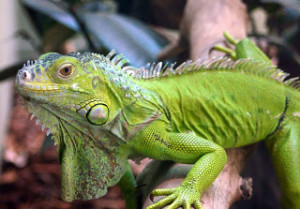
Nowadays, owners of pets do not just settle for the usual dogs and cats as their animal pets. There is a growing trend among people who want pets to go as exotic as possible. No wonder there are actually pet lovers who have turtles, salamanders, snakes and even iguanas as their pets. Iguanas as pets have risen in popularity for the past years because they have proven themselves to be amazing pets. However, exotic pets like iguanas require special care and maintenance that may actually be expensive and time consuming. Green iguanas are usually found in the tropical forests of the Caribbean Islands, Central and South America. They usually live in low altitudes, near sources of water like streams. Most of their time is spent on the forest canopy that can reach 50 feet above the ground. Iguanas that are being made into pets are usually green iguanas which grow between four to six feet, with some even reaching lengths of seven feet. This length of iguanas is composed of their bodies and the tail, which can reach more or less half the body length. This long tail is also sharp, which iguanas also use to defend themselves against predators. The iguana’s tail may break or snap if a predator catches it, but it will eventually grow back. Aside from the iguana’s predominant green color, its skin also contains black stripes. Not all green iguanas have the same shade, as many iguanas come in various shades ranging from bright to a dull shade almost closer to gray. The green color of iguanas camouflages them amidst the forests which are their natural habitats. Green iguanas climb and grasp through the branches of trees, which makes their long claws and fingers very useful. Iguana skin is rough and tough, which makes it resistant against cuts and scratches, as well as water. It contains some pointy scales located on the back portion of the lizard. Green iguanas have highly developed senses of vision, hearing and smell. They also have superb diving abilities, allowing them to escape predators by diving from one tree to another, or from a height of up to 50 feet to the ground without hurting themselves. Male green iguanas have a dewlap or a flap of skin which they raise to intimidate enemies or to impress females (much like male peacocks and their fanned tails). Iguanas have the ability to keep fat under their necks and jaw area which they can use for storing purposes, just like camels and their humps. Pet owners find iguanas as pets ideal because they don’t cause too much, if any, damage to property and don’t really create any noise or disturbance. Iguanas are up during the day and are cold-blooded, which means cannot produce their own body heat. Green iguanas love staying outdoors and bask in the sun or lie on warm surfaces so that they can stay warm. Iguanas as pets bring a sort of prestige to hard core animal lovers. Exotic pets such as an iguana are known to pet lovers as a challenge. Even though iguanas seem docile and do not really get to move a lot, their long claws and sharp tails do not really make them the easiest animals to deal with. Thus, only hard core and extreme pet lovers would really consider having a pet iguana. It can be rewarding in the end though, as having a pet iguana can certainly be an interesting thing to observe and can be a sure conversation piece. Before getting into the hard work of taking care of iguanas as pets, the interested pet owner should need to know how to select an iguana first. As mentioned earlier, there are a lot of iguana varieties, although the green iguana is the most popular. There are the more “exotic” varieties such as those with blue skin with orange spikes. Although the ones that have more “exotic” skin color can be enticing, there is really no difference between these varieties except for skin color. More than considering the skin color, one should be more cautious of the iguana’s health. Included in things one should look for would be the clarity of the eyes and the “smoothness” of the skin. Everybody knows that the skin of an iguana is rough, but the “smoothness” mentioned earlier means that the iguana’s should not be flaky, not missing scales and back spikes. Although iguanas are not really known to be the most active of lizards, it would be better if an iguana moves around and interacts a bit with its potential owner. Despite looking stoic most of the time, iguanas as pets can actually be ill-tempered, especially when faced with anything that disturbs its otherwise peaceful existence. When petting or interacting with an iguana, an iguana owner should be ready with leather gloves that reach the shoulder. Otherwise, he or she should be ready for a lot of clawing and tail lashings. Fully-grown iguanas can do a lot of harm with its claws and tails, so children should not be allowed to pet or handle them. Iguanas do not have the ability to recognize their masters or owners, and there is no such thing as iguana obedience schools like those for dogs. Thus, it is the owner’s responsibility to adjust to his or her pet iguana, as there is no other way. The iguana owner should also consider diet, which should be a combination of calcium and protein-rich vegetables and fruits. Lastly, the iguana cage should resemble the iguana’s natural habitat, so it should be filled with branches, leaves, and most of all, should be spacious.